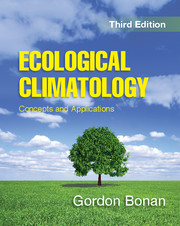Book contents
- Frontmatter
- Dedication
- Contents
- Preface
- 1 Ecosystems and Climate
- Part I The Earth System
- Part II Global Physical Climatology
- Part III Hydrometeorology
- Part IV Biometeorology
- Part V Terrestrial Plant Ecology
- 18 Plant Strategies
- 19 Populations and Communities
- 20 Ecosystems
- 21 Soil Biogeochemistry
- 22 Vegetation Dynamics
- 23 Landscapes and Disturbances
- 24 Global Biogeography
- Part VI Terrestrial Forcings and Feedbacks
- Appendix
- Index
- Plate section
- References
23 - Landscapes and Disturbances
from Part V - Terrestrial Plant Ecology
Published online by Cambridge University Press: 05 November 2015
- Frontmatter
- Dedication
- Contents
- Preface
- 1 Ecosystems and Climate
- Part I The Earth System
- Part II Global Physical Climatology
- Part III Hydrometeorology
- Part IV Biometeorology
- Part V Terrestrial Plant Ecology
- 18 Plant Strategies
- 19 Populations and Communities
- 20 Ecosystems
- 21 Soil Biogeochemistry
- 22 Vegetation Dynamics
- 23 Landscapes and Disturbances
- 24 Global Biogeography
- Part VI Terrestrial Forcings and Feedbacks
- Appendix
- Index
- Plate section
- References
Summary
Chapter Summary
Landscapes are another level of ecological organization, merging the concepts of populations, communities, and ecosystems. A landscape is a mosaic of communities and ecosystems formed by a gradient of environmental conditions. The pattern of vegetation in a landscape arises due to gradients in temperature, soil moisture, and other environmental factors. It also arises from disturbances such as fire, forest clearing, or farm abandonment that initiate secondary succession. Post-disturbance succession creates a mosaic of communities and ecosystems in various stages of development. These communities and ecosystems occur as distinct patches across the landscape. Patches are homogenous units of land with similar topography, soil, microclimate, and vegetation. Patches are the individual elements of the landscape and are embedded in a matrix of other patches, which forms the pattern of the landscape. Fire and human uses of land are important processes creating pattern in landscapes. Changes in the disturbance regime alter the structure and composition of a landscape and so alter exchanges of energy, water, and chemical constituents with the atmosphere.
Pattern and Process in Plant Communities
Many ecologists long viewed natural systems as being in balance and in equilibrium with the environment. The Clementsian view of plant succession held that succession is orderly, predictable change that culminates in a stable, climax ecosystem that represents an equilibrium balance of functions. However, this equilibrium view of nature is flawed. Fires, floods, hurricanes, herbivores, insects, and people regularly disturb plant communities, initiating the successional cycle. In this non-equilibrium view, the landscape is a mosaic of successional communities whose composition and structure are determined by the type and severity of disturbance. Disturbance and the resulting successional development of communities and ecosystems are the processes giving rise to the mosaic pattern of vegetation in the landscape (Watt 1947; Pickett 1976; Whittaker and Levin 1977; Bormann and Likens 1979; Shugart 1984). These disturbances can be as small as a 100 m2 gap in the canopy created by the death of a large dominant tree or as large as hundreds of square kilometers following fire.
Disturbance removes existing vegetation and creates an environment with high sunlight and reduced competition for resources. These conditions favor the germination, establishment, and growth of early successional species. Early successional plants are maintained in the landscape by a fugitive life history and recurring disturbance.
- Type
- Chapter
- Information
- Ecological ClimatologyConcepts and Applications, pp. 400 - 421Publisher: Cambridge University PressPrint publication year: 2015



